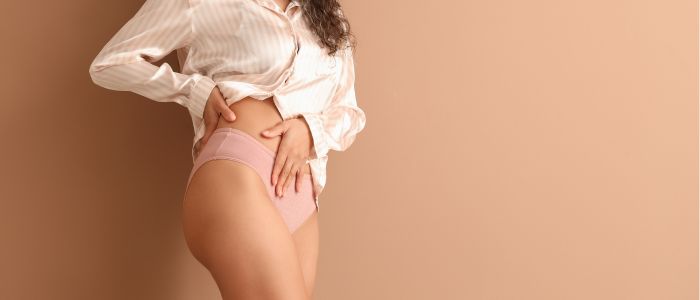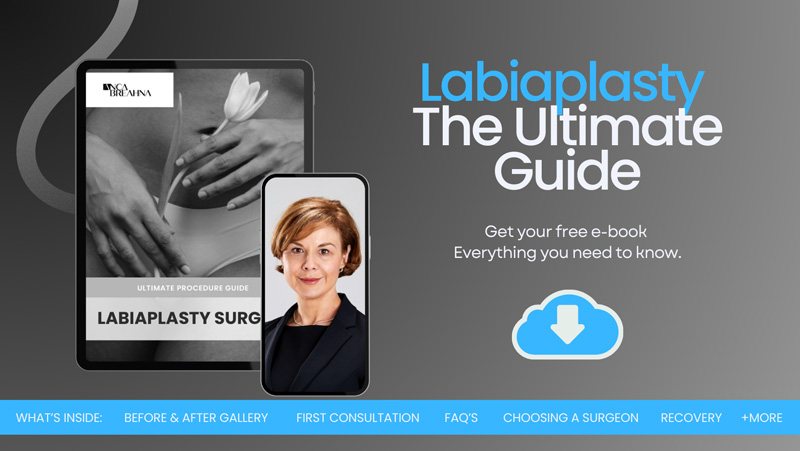
Solutions for Enlarged Labia: the Complete Guide
Enlarged labia, or labial hypertrophy, refers to the condition where the labial tissues in the vulva area are larger than usual. Some women are looking for solutions for enlarged labia. While this can be a natural variation and not a health concern, it can cause discomfort or emotional distress for some women. It’s important to understand that there is a wide range of normal sizes when it comes to labia, and what might be larger for one person may be average for another.
Consultant Plastic Surgeon Anca Breahna discusses different treatments and solutions for enlarged labia, including labiaplasty surgery.
Download Anca Breahna’s Labiaplasty Guide

What Does Enlarged Labia Mean?
The term “enlarged labia” can refer to either the labia minora or the labia majora, though it more commonly pertains to the labia minora. Some women may notice that their labia minora extends beyond the labia majora, which can be due to genetic factors, hormonal changes, or other conditions. It’s essential to recognise that this is generally a normal anatomical variation.
Living with enlarged labia can affect more than just your physical health, many women might feel uneasy about their body’s appearance due to societal pressures and personal expectations.
Concerns about labia size can sometimes create tension in intimate relationships. You might worry about how a partner might perceive you or fear negative comments. However, it is important to communicate openly with your partner. Often, concerns about appearance are not shared by partners, who may value openness and intimacy over physical specifics.
Medical Evaluation for Enlarged Labia
If you’re considering a medical evaluation for enlarged labia, it’s important to prepare for the consultation and understand what to expect. A thorough medical evaluation can help address any physical discomfort and discuss potential treatment options, ensuring you receive the right support and information.
What to Expect During Your Consultation
During your initial consultation, Anca will discuss your medical history and the specific concerns you have about your labia. You can expect a physical examination, which is carried out in a respectful and professional manner to assess the physical characteristics of your labia. This helps determine if the enlargement is within normal anatomical variations or if it’s something that might benefit from medical intervention.
Key Questions to Ask Anca
To get the most from your consultation, it’s helpful to prepare some questions:
- What are the possible causes of my labia enlargement?
- Are there any non-surgical treatments that could alleviate discomfort?
- What are the benefits and risks of labiaplasty?
- What kind of follow-up care is required if I choose a surgical option?
These questions can help clarify your options and set realistic expectations for any potential treatments.
Diagnostic Tests and Assessments
In most cases, the evaluation of enlarged labia does not require extensive diagnostic tests. However, Anca might perform certain assessments to rule out other conditions, such as hormonal imbalances or skin disorders that could contribute to your symptoms. If there are signs of an underlying condition, additional tests may be recommended to ensure comprehensive care.
A medical evaluation is an important step in understanding and addressing any issues related to enlarged labia. It provides a platform to discuss your concerns, explore treatment options, and plan the best course of action tailored to your individual needs.
Non-Surgical Treatments
When considering treatment for enlarged labia, it’s valuable to know that several non-surgical options can help alleviate discomfort and improve quality of life. These treatments range from simple lifestyle adjustments to specific medications, depending on the severity and nature of your symptoms.
Lifestyle Adjustments and Home Remedies
Simple changes in your daily routine can significantly impact your comfort levels. Opting for looser clothing and underwear can reduce irritation and discomfort associated with enlarged labia. Additionally, maintaining good hygiene and using unscented products can help minimise any potential skin irritation. Some women find relief by applying cold compresses to reduce swelling after prolonged activities like cycling or running.
Medications and Topical Treatments
If irritation or swelling is a concern, Anca may recommend topical ointments to help soothe the area. These might include steroid creams to reduce inflammation or anaesthetic creams to alleviate pain during specific activities. It’s important to use these products under the guidance of Anca to avoid any adverse effects.
Surgical Options for Labia Reduction
For some women, non-surgical treatments might not sufficiently address the discomfort or aesthetic concerns associated with enlarged labia. In such cases, surgical options like labiaplasty might be considered. Labiaplasty involves reshaping or reducing the labia minora or labia majora to alleviate discomfort, reduce size, and improve appearance. Labiaplasty is usually performed as an outpatient procedure under local anaesthesia, with or without sedation. The surgery involves trimming excess labial tissue to reduce its size and improve the overall aesthetic of the genital area. The goal is to achieve a size and shape that reduces physical discomfort and meets your aesthetic desires, while maintaining natural colour and sensation.
Surgical Techniques for Labiaplasty
Labiaplasty, a surgical procedure designed to reshape or reduce the size of the labia minora and/or labia majora, employs different techniques tailored to meet the specific needs and aesthetic goals of the patient. Understanding these techniques can help women make informed decisions about the procedure. Below, we explore the most common techniques used in labiaplasty, highlighting how they differ and the outcomes they aim to achieve.
Trim Technique
- Description: The trim technique is the most straightforward approach to labiaplasty. It involves trimming the excess edge of the labia minora that protrudes beyond the labia majora. The excess tissue is excised along the length of the labia, usually from the clitoral hood down to the perineum.
- Benefits: This method is effective for removing darkened or irregularly textured edges of the labia minora. It’s often preferred by women looking for a more “tidy” or uniform appearance along the edge of the labia.
- Considerations: While this technique can provide a clean, linear edge, it may also lead to a slight increase in the risk of nerve sensitivity changes since it involves cutting near sensitive tissues.
Wedge Technique
- Description: The wedge technique involves removing a pie-shaped piece of tissue from the thickest part of the labia minora. The remaining edges are then sutured together, which reduces the bulk while preserving the natural border and colour of the labia edges.
- Benefits: This method maintains the natural contour of the labia edges and is less likely to alter sensation because less nerve-dense tissue is removed.
- Considerations: The wedge technique requires precise execution to ensure that the remaining tissue heals in a way that doesn’t distort the natural folds. It’s also essential to ensure that blood flow to the remaining tissue is sufficient to support proper healing.
Central De-epithelialisation Technique
- Description: Central de-epithelialisation involves removing a strip of tissue from the central part of each labium while leaving the natural edges intact. This technique decreases the size of the labia without affecting the natural rim.
- Benefits: Like the wedge technique, it preserves the natural edge and colour of the labia. It’s particularly suitable for reducing volume without altering the fundamental shape.
- Considerations: The success of this technique heavily depends on the precise removal of tissue and careful suturing to prevent irregular contours post-surgery.
Labia Majora Reduction
- Description: For the labia majora, the surgical approach may involve excising excess skin and fat to reduce bulging and achieve a more toned appearance. In some cases, liposuction is used to remove fatty tissue, or a lifting technique is applied to tighten the area.
- Benefits: This procedure can significantly enhance comfort and the aesthetic appearance of the labia majora, particularly in cases where sagging or bulging is pronounced.
- Considerations: Post-operative swelling can be significant, and there’s a need for careful management to avoid asymmetry or over-reduction.
Each of these labiaplasty techniques offers unique advantages and considerations. Choosing the right technique depends on your anatomy and the desired outcome. A detailed consultation with Anca is essential to discuss these options and determine the most appropriate technique based on personal needs and goals.
Preparing for Surgery
Preparation for labiaplasty involves several steps to ensure the best possible results and a smooth recovery. You will need to:
- Avoid certain medications and supplements that can increase bleeding risk.
- Arrange for someone to drive you home after the procedure.
- Prepare your home for a comfortable recovery, setting up a quiet space where you can rest without disturbance.
Choosing to undergo labiaplasty is a personal decision that should be made based on thorough consultation with Anca. She will help assess your suitability for the surgery, explain the procedure in detail, and help manage expectations based on your individual circumstances.
Recovery and Aftercare Following Labiaplasty
After undergoing labiaplasty, the focus shifts to recovery and aftercare to ensure the best possible outcomes and minimise the risk of complications. Proper aftercare is essential for healing and can significantly affect the results of your surgery.
Immediate Post-Operative Care
Immediately following the procedure, you may experience swelling, discomfort, and some bruising, which are normal. Anca will provide pain relief options and advise on how to sit or lie down to minimise discomfort. It’s crucial to follow these guidelines:
- Use ice packs to reduce swelling during the first 48 hours
- Keep the surgical area clean and dry, and apply any prescribed ointments to prevent infection
- Avoid any strenuous activities and sexual intercourse for the recommended period, usually about 4-6 weeks
Long-Term Care and Monitoring
As you recover, you’ll need to monitor the surgical site for any signs of infection or complications, such as increased pain, redness, or unusual discharge. Regular follow-up appointments with Anca are important to ensure that the healing process is progressing well. During these visits, discuss any concerns you might have and confirm the next steps in your recovery.
Signs of Complications to Watch For
While labiaplasty is generally safe, like any surgical procedure, it carries risks. Be vigilant for symptoms that could indicate a problem, such as:
- Persistent pain that doesn’t improve with pain relief measures
- Any signs of infection, including fever, severe swelling, or odorous discharge
- Splitting of the sutures or delayed healing of the incision sites
If you experience any of these symptoms, contact Anca immediately for assessment and possible treatment.
FAQs about Treatments and Solutions for Enlarged Labia

What are the risks associated with non-surgical treatments for enlarged labia?
While non-surgical treatments are generally considered safe, they can carry certain risks depending on the specific method used:
- Topical Treatments: Over-the-counter creams and ointments may cause allergic reactions or skin irritation if not used as directed. It’s important to follow the instructions and seek guidance from Anca.
- Herbal Remedies: Supplements and herbal treatments can interact with medications and may not be safe for everyone, especially pregnant or nursing women. Always consult your doctor before starting any new herbal regimen.
How do I know if I am a good candidate for labiaplasty?
- Ideal candidates for labiaplasty are women who experience physical discomfort, hygiene issues, or psychological distress due to the size or shape of their labia. You should be in good overall health, have realistic expectations about the outcomes, and not be currently pregnant or nursing. A consultation with Anca is necessary to assess your suitability for the procedure.
Can lifestyle changes really help manage discomfort from enlarged labia?
Yes, certain lifestyle adjustments can significantly alleviate discomfort associated with enlarged labia:
- Clothing Choices: Opting for loose-fitting trousers and skirts can reduce friction and irritation. Breathable, cotton underwear can also help prevent moisture build up and irritation.
- Hygiene Practices: Regular washing with mild, unscented soap and avoiding vaginal douches or irritating products can decrease discomfort and risk of infections.
- Activity Modifications: Adjusting how you engage in activities that cause discomfort, like cycling with a padded seat or avoiding certain exercises, can make a significant difference.
Are there any long-term complications of undergoing labiaplasty?
Labiaplasty has a high satisfaction rate, but like all surgeries, it can have long-term complications, which might include:
- Chronic Dryness or Irritation: Some patients may experience changes in tissue that can lead to increased sensitivity or dryness.
- Aesthetic Dissatisfaction: In some cases, patients may not be satisfied with the aesthetic outcome, which might necessitate revision surgery.
- Scarring and Changes in Sensation: While rare, some women may develop noticeable scarring or experience a change in sensation that can affect sexual pleasure or comfort.
Further Reading about Labiaplasty Surgery at Cheshire Cosmetic Surgery
- Read more about Labiaplasty Types – Trim Labiaplasty and Wedge Labiaplasty or Hybrid
- Read more about What Are the Trim and Wedge Methods for Labiaplasty Surgery?
- Read more about Labiaplasty vs Vaginoplasty
- Read more about Recovery after Labiaplasty
- Read more about Exercise after Labiaplasty
- Read more about Treatments and Solutions for Sagging Vulva
- Read more about 10 Questions to Ask Your Surgeon before Labiaplasty Surgery
- Read more about Body Condition: What are Enlarged Labia?
- Read more about What Are Large Labias? – Causes and Treatments
Medical References about Large Labia
- Labia Minora Hypertrophy: Causes, Symptoms – WebMD
- Labial hypertrophy: Causes, side effects, and treatment – Medical News Today
- Average Labia and Clitoral Length – News Medical
- Premenarchal labia minora hypertrophy – PubMed
- Labia Minora, Labia Majora, and Clitoral Hood Alteration – Oxford Academic







